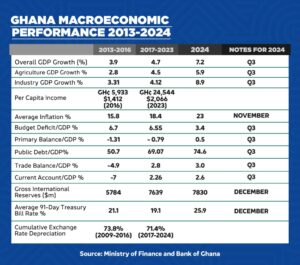adverts
As the Akufo-Addo/Bawumia administration nears the end of its tenure, it has mounted a robust defence of its economic record, claiming to have outperformed the Mahama-led government in 10 out of 13 key macroeconomic indicators.
With data from the Bank of Ghana and the Ministry of Finance as evidence, the outgoing government has argued that it leaves behind a stronger economic foundation despite facing unprecedented global challenges, including the COVID-19 pandemic.
The Akufo-Addo administration has particularly touted its achievements in GDP growth, pointing to a sharp contrast between its economic management and that of the Mahama government.
adverts
- Mahama (2016): 3.9% GDP growth rate.
- Akufo-Addo (2024): 7.2% GDP growth rate, even in the aftermath of COVID-19 disruptions.
The government credits this growth to strategic economic policies and initiatives that stimulated key sectors, particularly agriculture and industry.
Agriculture
The Akufo-Addo administration claims significant success in agricultural growth, largely due to flagship programs like “Planting for Food and Jobs.” These initiatives reportedly boosted productivity and contributed to food security.
Industry
Policies such as the “One District, One Factory” program have been cited as catalysts for industrial growth, fostering job creation and diversifying the economy.
Trade and Fiscal Discipline
The outgoing government highlighted its performance in trade, achieving a surplus and reducing the current account-to-GDP ratio. It also pointed to better fiscal discipline, with a narrower budget deficit and an improved primary balance.
Mahama’s Strengths: Inflation, Debt, and Interest Rates
While touting its achievements, the Akufo-Addo administration acknowledges areas where the Mahama administration outperformed:
- Public Debt Management
- Under Mahama, public debt levels were lower compared to the rapid debt accumulation during the Akufo-Addo era.
- Inflation Control
- The Mahama government maintained a lower average inflation rate, reflecting relative price stability.
- 91-Day Treasury Bill Rate
- Short-term interest rates were more favourable under Mahama, reducing borrowing costs for businesses and individuals.
Comparative Breakdown of Economic Indicators
| Indicator | Mahama (2016) | Akufo-Addo (2024) |
|---|---|---|
| GDP Growth Rate | 3.9% | 7.2% |
| Agricultural Growth | Modest | Accelerated |
| Industrial Growth | Slower | Significant |
| Per Capita Income | Lower | Higher |
| Budget Deficit | Larger | Narrower |
| Primary Balance | Negative | Improved |
| Trade Balance | Deficit | Surplus |
| Current Account-to-GDP Ratio | Higher Deficit | Lower Deficit |
| Gross International Reserves | Lower | Higher |
| Exchange Rate Depreciation | Higher | Lower |
| Public Debt | Lower | Higher |
| Average Inflation | Lower | Higher |
| 91-Day Treasury Bill Rate | Lower | Higher |
The Akufo-Addo government has repeatedly emphasised that its tenure was marked by external shocks, particularly the COVID-19 pandemic. These disruptions, it argues, created unprecedented economic pressures but also highlighted the resilience and adaptability of its policies.
As President Nana Addo Dankwa Akufo-Addo and Vice President Dr. Mahamudu Bawumia prepare to exit, their economic legacy remains a subject of fierce debate. Supporters applaud their achievements in GDP growth, trade performance, and industrial development, while critics point to rising debt, inflation, and the cost of living as areas of concern.



